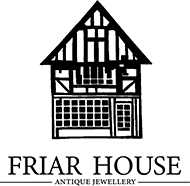Paste jewellery is essentially hand cut transparent flint glass that has been cut to simulate the brilliance of gemstones and is cut into gem like forms. Paste dates back to Roman times when copies of emerald and lapis lazuli were made. With an increasing demand for jewellery the number of paste items produced, steadily increased. Paste was used extensively from the 1700’s to the early 1900’s.
In the mid 1700’s a Viennese goldsmith invented the art of simulating diamonds using colourless glass paste, cut in such a way that superficially they looked like the genuine stone.
Coloured stones were achieved by adding pigments to the paste, of the desired colour, chromium for red or green, cobalt for blue, gold for red, and iron for yellow to green, manganese for purple. Paste could also be made in cabouchon form to almost replicate opals.
Pastes are often softer than ordinary glass but because of the higher index of refraction and light dispersion they add a good brilliance and fire to the stones. Most paste came from France, England, Germany, Portugal and Spain.
Cheaper paste imitations are made by pressing or moulding glass rather than hand cutting and polishing the facets. Paste has air bubbles, is a poor conductor of heat and is a softer substance.
Paste could be set into silver or gold and have foiled or unfoiled backs. Typically 18th century paste was always foiled. Foiled pastes, usually mounted in closed back settings have added brilliance and reflection. Paste could be more easily cut and shaped than diamonds which made it easier to create a close fitting pave look.






